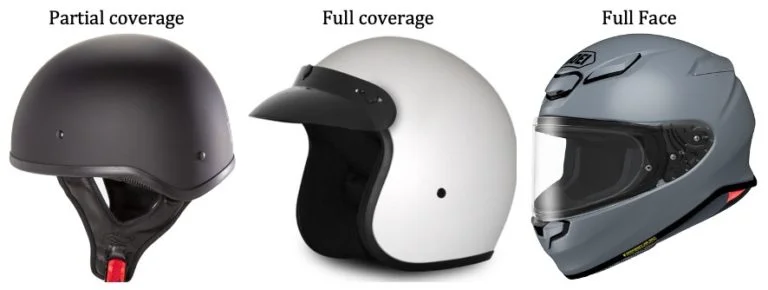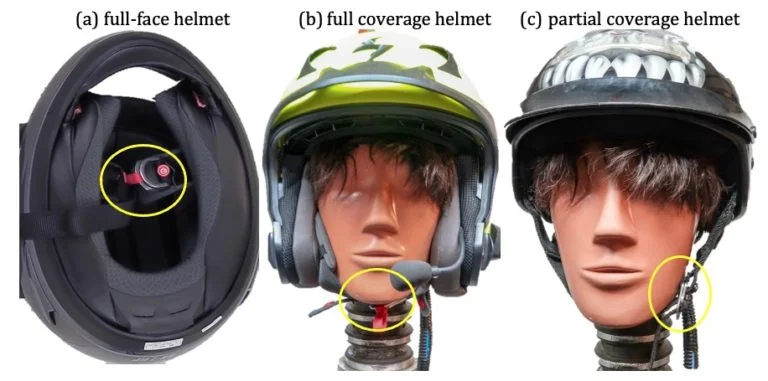Dr. Lloyd published a new peer-reviewed scientific article regarding the failures of motorcycle helmet retention systems in the Journal of Forensic Biomechanics, September 2022. Click to download a PDF copy
Motorcycle helmets are typically grouped into three categories: partial coverage (aka shorty or half) helmets, which, by design, do not extend over the rider’s ears; full coverage (aka three-quarter) helmets, which extend over the rider’s ears and further down the back of the head, but offer no face protection; and full-face helmets, which are similar to full coverage, but also include a chin bar to afford some protection against facial impacts.
Figure 1: Motorcycle helmet styles

Motorcycle helmets are secured to the rider’s head by means of a retention system. The most common retention system utilized on motorcycle helmets involves a strap, originating from one side of the helmet, which is secured to the opposite side using a ‘Double-D ring’ mechanism. The motorcycle helmet retention strap is passed through the centers of the two D-rings, then over the outer ring and back through the inner ring (composite Figure 2). It is well accepted that motorcycle helmets may be ejected from a rider’s head during a collision event due to user error, mechanical failure, or design defect.
Figure 2: Operation of Double-D ring helmet retention system

When tightened the Double-D ring retention system is generally very effective in preventing a helmet from being ejected off the rider’s head. The strength of the Double-D ring helmet retention system lies in the friction generated between the retention strap and the D-rings, which is maximized when the D-rings and strap are parallel. The procedure to release this retention system involves lifting the D-rings so they are no longer parallel with the strap, thereby reducing the friction between the strap and D-rings, which allows the strap to slide freely.
However, operation of the Double-D ring retention system is not intuitive to a novice user, who will require some education on its operation. Without training many new users will fail to properly secure their helmet, which can lead to inadvertent ejection of the helmet. Such user error was reported as the number one cause of crash-related motorcycle helmet ejections in both the United States Hurt study [1] and European MAIDS study [2]. This has given rise to alternative, simpler retention systems, such as quick release buckles and ratcheting (micrometric) fasteners, though mechanical failure rates of these devices tend to be higher, particularly for products with non-metal components.
Figure 3: Quick release buckle and micrometric retention systems

Hurt, Thom and Ouellet presented a study ‘Testing the Positional Stability of Motorcycle Helmets’ at the 16th International Technical Conference on the Enhanced Safety of Vehicles (ESV), held in Windsor, Canada in 1998 [3]. This study was later presented in near identical, albeit abbreviated form, at the Human Factors and Ergonomics congress in 2000, with D. Thom as lead author [4]. In their study, human subjects were asked to try to pull a tightly fastened helmet off their head. The total number of human participants or tests is not reported. Results illustrate that one of the selected partial coverage (shorty) helmet models was ejected with minimal to moderate resistance in more than 80 percent of tests, whereas the tested full facial coverage helmets remained on the subjects head in more than 99 percent of tests.
Epidemiological data pertaining to motorcycle crashes indicates that helmet ejection is a more common occurrence among riders who wear partial coverage helmets 1. The authors opine that unfastened and loose-fitting helmets account for most crash-related helmet ejections. Whereas, in their 1998 and 2000 presentations 3,4, Hurt and Thom extend this opinion to include loose fastening of the chin strap, without offering supporting evidence. For this new speculation to be true, a direct correlation must exist between improperly fastened retention systems and helmet choice, suggesting that riders who choose to wear a shorty motorcycle helmet were considerably far more likely to improperly fasten the retention strap. Clearly, it is illogical to suggest a purely causal link between helmet choice and human behavior.
Further investigation has identified a fundamental design difference between partial helmets and full coverage / full-face helmets. Specifically, the retention system on full-face and full coverage motorcycle helmets fastens under the chin of the rider (Figure 4a & 4b), while partial coverage helmets tend to fasten on the side of the face (Figure 4c).
Figure 4: Retention fastener location

When fastened, the double-D rings and retention strap on full-face and full coverage motorcycle helmets are near-parallel, thereby maximizing the friction on the strap. The strength of the retention system is thus optimized. Whereas, on many partial coverage helmets, the double-D rings are located on the side of the face, producing an oblique angle between the retention strap and D-rings, which reduces the friction on the retention strap, similar to the orientation required to release the retention system . Hence, during a collision event and in accordance with the laws of physics, the force acting on the retention system of a partial coverage helmet can exceed the friction between the retention strap and D-rings on the side of the face, allowing the strap to loosen and the helmet thereby be ejected from the rider’s head.
This deductive reasoning is consistent with the physical design difference between full and partial coverage helmets, accounts for the epidemiological evidence of increased incidence of ejection of partial coverage helmets, addresses the physical evidence of seemingly loose retention straps on post-collision partial coverage helmets and also explains the findings of the Hurt and Thom study in which more than 80 percent of human subjects were able to easily remove a properly tightened partial coverage helmet from their heads.
Conclusions
The reason for the different design location of the double-D rings on partial coverage helmets compared to full-face and full coverage helmets is not known. Based on the above deductive reasoning it is imperative that manufacturers of shorty motorcycle helmets modify the retention system design to allow the D-rings and strap to be fastened under the rider’s chin. In doing so, ejection rates among short motorcycle helmets will be substantially reduced, thereby affording riders enhanced protection during crashes.
References
[1] Hurt HH, Ouellet JV & Thom DR. (1981). Motorcycle Accident Cause Factors and Identification of Countermeasures. NTIS PB-206 443, PB-206 450, 1981.
[2] ACEM (2009) MAIDS (Motorcycle Accidents In Depth Study): In-depth investigations of accidents involving powered two wheelers – Final Report 2.0. European Association of Motorcycle Manufacturers.
[3] Hurt HH, Thom DR & Ouellet JV. (1998). Testing the Positional Stability of Motorcycle Helmets. Presented at 16th International Technical Conference on the Enhanced Safety of Vehicles (ESV), Windsor, Canada.
[4] Thom DR, Ouellet JV, Smith TA & Hurt HH. (2000). Evaluating the Positional Stability of Motorcycle Helmets. Proceedings of the IEA / HFES Congress.
